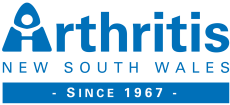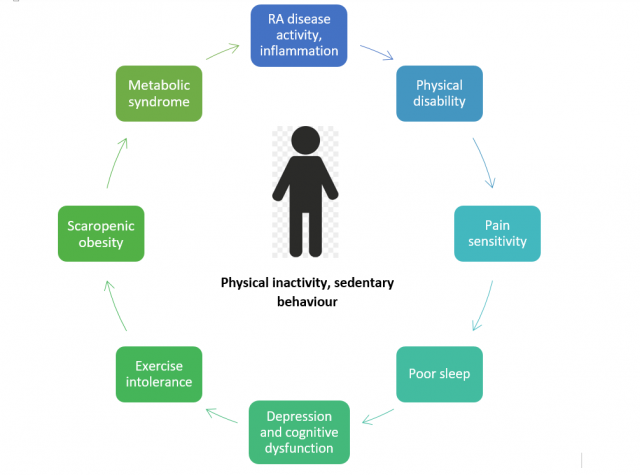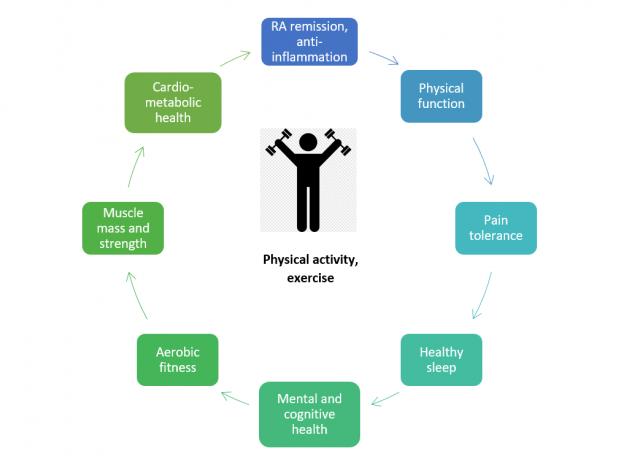Question:
There is a lot of focus on exercise for osteoarthritis (OA). I have Rheumatoid Arthritis (RA) and since RA is different to OA, can I and should I exercise?
Answer:
Another common question I get via both our Infoline and email is whether people can or even should exercise with RA. And the short answer is yes, those people with RA can still exercise, and yes, they most certainly should!
Firstly, what is RA?
There are over 100 conditions grouped under the umbrella term ‘arthritis’. The most common type of arthritis is OA, followed by RA and Gout. Each type of arthritis affects the number and location of joints in our body differently, however, many of these conditions share similar symptoms, including joint pain or tenderness, joint stiffness, swelling, joint warmth and/or redness, difficulty moving joints normally and fatigue. One of the biggest differences between types of arthritis is its cause. For example, the exact cause of OA is still unknown, however, it is thought to be due to a complex mix of risk factors, such as mechanical factors (e.g. injury), lifestyle factors (e.g. obesity, diabetes, and systemic, chronic low grade inflammation) and gender (e.g. females are more susceptible to OA). Alternatively, RA is caused by the activation of a “faulty” or over sensitive immune system, hence it is known as part of a cluster of conditions called an autoimmune condition (however, what causes an autoimmune condition is also still unknown). Also, unlike OA, RA has a strong genetic/heredity link and symptomatic onset can be very rapid (over weeks or months) and may begin any time in life, whereas the onset of OA is usually gradual and presents later in life.
In RA, the immune system commonly targets the lining of joints, causing inflammation and joint damage. Symptoms can include painful, swollen, stiff, warm, and tender joints. People with RA often notice changes in symptoms over time, with ‘flare-ups’ (i.e., where symptoms become for active and intense) followed by periods of decreased inflammation. Because RA is a systemic disease, or a disease that targets the whole body, many joints and other organs can be affected (e.g. eyes or lungs). While RA can target any joint, it often affects the peripheral joints, such as the joints in the hand, wrist, ankle or foot before potentially moving on to larger loadbearing joints.
Physical Activity Levels and Barriers in People with Rheumatoid Arthritis
Similar to OA, exercise was once thought to exacerbate inflammation and disease activity of RA. However, it is now recognised as safe and is recommended for people with RA (1). Exercise and physical activity have well-documented benefits on improving RA aerobic capacity, as well as helping to manage obesity, metabolic syndrome, cancer risk, and cardiovascular disease morbidity and mortality. Figure 1 (1) provides an overview of the harm of physical inactivity and sedentary behaviour verses the benefits of physical activity and exercise in RA.
Figure 1 (1)
In spite of recommendations and evidence supporting the benefits of exercise, most people with RA are largely inactive (2-6). For example, a study including over 5000 participants with RA, from 21 countries, found that only (approximately) 14% reported exercising at least three times/week (4).
This is due to a variety of factors and barriers, including:
Physical and disease-specific barriers
- Being female
- Older age
- Lower socioeconomic status (SES) and education
- Disease activity
- Radiographic joint damage (i.e. joint damaged shown by X-ray)
- Fatigue
- Pain
Psychological barriers
- People reporting a lack of motivation
- Fear Avoidance i.e., poor/misguide beliefs that exercise will cause their joints harm
- Negative expectations of the effects of exercise
- Lack of knowing what exercises to do
Unfortunately, research highlights that the greatest barrier may be that people with RA are not receiving the message from doctors and other healthcare providers that physical activity is beneficial (7). Although doctors and specialist healthcare providers may feel exercise is important for those people with RA, they may not feel competent in providing physical activity advice.
Exercise and RA disease activity
Contrary to past beliefs (i.e. fears that physical activity and exercise would worsen disease activity and joint structures), studies consistently show associations with physical activity/exercise and lower disease activity and systemic inflammation (8,9). Furthermore, studies show exercise does not increase radiographic joint damage (8,9). Both aerobic and strength training (respectively) have shown to improve clinically measured disease activity. Not surprisingly, combined aerobic (18) and strength training programs (19) also improve disease activity, potentially to a greater extent than either aerobic or strength training alone (20, 21). High intensity interval training (HIIT) (i.e. high intensity bouts of exercise followed by low intensity bouts) has also shown to significantly improve clinically measured disease activity (10). There is only one caveat to HIIT training; there is a small risk to worsening previously damaged joints, specifically the shoulder and ankle joint (1). If this is relevant to you, please don’t let this information deter you from exercising. Instead, just be mindful that high intensity exercise e.g., high impact jumping, skipping, difficult terrain bush walking or running/sprinting, may be something to do less of or avoid depending on the health of your joints. If you feel it is appropriate for you or you’d like to try HIIT training, please engage in it under the guidance of an appropriately skilled health professional.
Benefits of Exercise in RA
Other than clinically improving disease activity, exercise also improves other symptoms of RA including pain, fatigue and functional limitations.
Previous studies among adults with RA have shown reductions in perceived pain after participating in exercise programs (11-13). It was once thought, or perhaps still is, that exercise would exacerbate pain, however, regardless of the modality of exercise, it seems evident that exercise can reduce perceived pain in people with RA. How and why this occurs is still unclear. It has been suggested that exercise releases endorphins that may inhibit the transmission of pain (1). There is also evidence that exercise may modulate central pain processing mechanisms and that the intensity of exercise may moderate pain sensitivity (1).
Only a handful of studies have been conducted on the effects of exercise and fatigue and sleep disturbances, however, outcomes have been positive. While many are correlational studies, people experience a decrease in fatigue and report better sleep quality when participating in regular exercise (14-17).
Lastly, a lack of physical activity/exercise has been associated with increased disability and loss of muscle mass in those with RA (1). However, higher levels of physical activity and exercise increases muscle strength and aerobic fitness, which in turn, may underlie the clinically measured improvements in functioning (1).
Q & A Summary of Exercise and RA
Can you exercise? Yes! It is safe to exercise and is recommended to do so.
Should you exercise? Yes! To gain the following benefits, yes, you certainly should exercise:
- Exercise doesn’t damage your joints
- Exercise improves your cardiovascular health, keep your weight down and buffers the development of sedentary disease (obesity, diabetes, heart attack etc)
- Exercise can reduce your perceived pain
- Exercise positively influences sleep and fatigue levels
- Exercise strengthens your muscles and improves your ability to move about and perform activities of daily living
I began this blog by stating that, yes people with RA can exercise and yes, they should. As you can see, it is extremely beneficial to exercise if you have RA, however, the key is to find what you like to do and balance that with what you can do. It’s all well and good that “Mary-Jo” with RA down the road likes yoga and does it four times a week, but yoga may not be for you. Perhaps you can’t contort your body into a pretzel, and that’s ok. Instead, you may like walking or running, in fact, walking may be the simplest way for many adults to increase their activity levels. Alternately, you may like to try non-weight bearing exercise like cycling or swimming, or you may really enjoy strength training. You need to find what works for your body and what you enjoy because whatever it is, that’s what you’ll likely stick to long term – and that’s what’s important; staying consistently active over time.
Please always consult with your doctor or an appropriate healthcare professional for guidance before engaging in exercise.
Read more about Exercise & RA on our Infosheet here.
Arthritis NSW – we’re here to help
We’re here to help whenever you need us. We have a variety of options available for support and information.
- For more BLOG articles about managing your arthritis, please visit our News page here.
- Sign up to eNews to get information and advice on managing your condition
- Call our free helpline on 1800 011 041 (Monday to Friday, 9am to 5pm)
- Join our online community: Follow us on Facebook or Instagram
- Subscribe to our magazine, more info here
- Become a member, more info here


